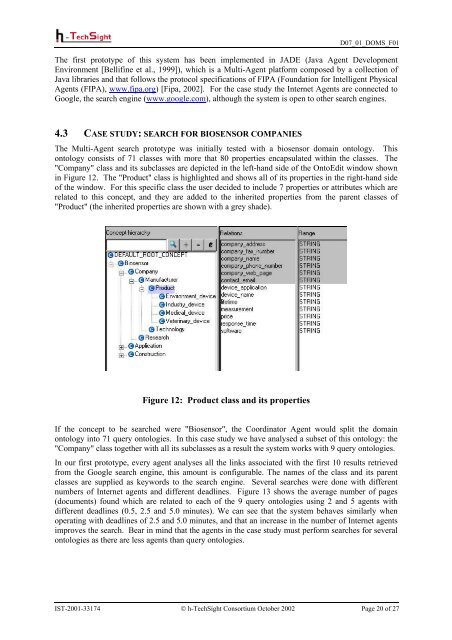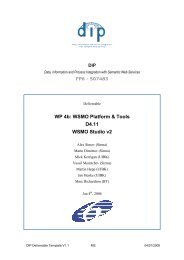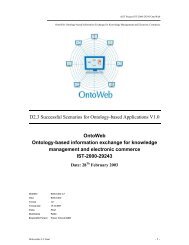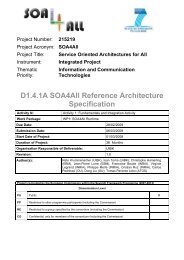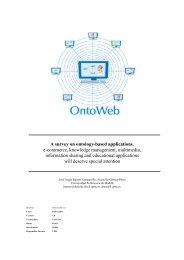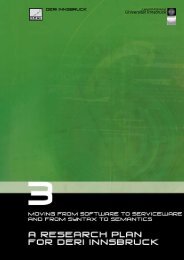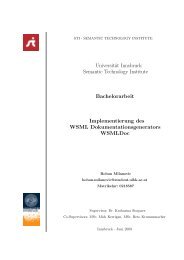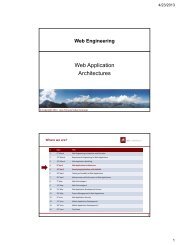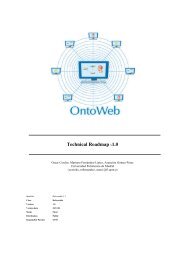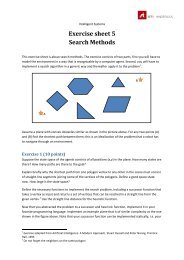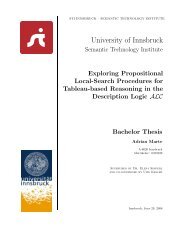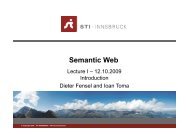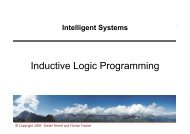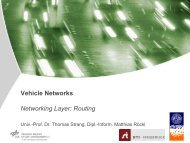D7 â Dynamic Ontology Management System (Design) - STI Innsbruck
D7 â Dynamic Ontology Management System (Design) - STI Innsbruck
D7 â Dynamic Ontology Management System (Design) - STI Innsbruck
You also want an ePaper? Increase the reach of your titles
YUMPU automatically turns print PDFs into web optimized ePapers that Google loves.
D07_01_DOMS_F01<br />
The first prototype of this system has been implemented in JADE (Java Agent Development<br />
Environment [Bellifine et al., 1999]), which is a Multi-Agent platform composed by a collection of<br />
Java libraries and that follows the protocol specifications of FIPA (Foundation for Intelligent Physical<br />
Agents (FIPA), www.fipa.org) [Fipa, 2002]. For the case study the Internet Agents are connected to<br />
Google, the search engine (www.google.com), although the system is open to other search engines.<br />
4.3 CASE STUDY: SEARCH FOR BIOSENSOR COMPANIES<br />
The Multi-Agent search prototype was initially tested with a biosensor domain ontology. This<br />
ontology consists of 71 classes with more that 80 properties encapsulated within the classes. The<br />
"Company" class and its subclasses are depicted in the left-hand side of the OntoEdit window shown<br />
in Figure 12. The "Product" class is highlighted and shows all of its properties in the right-hand side<br />
of the window. For this specific class the user decided to include 7 properties or attributes which are<br />
related to this concept, and they are added to the inherited properties from the parent classes of<br />
"Product" (the inherited properties are shown with a grey shade).<br />
Figure 12: Product class and its properties<br />
If the concept to be searched were "Biosensor", the Coordinator Agent would split the domain<br />
ontology into 71 query ontologies. In this case study we have analysed a subset of this ontology: the<br />
"Company" class together with all its subclasses as a result the system works with 9 query ontologies.<br />
In our first prototype, every agent analyses all the links associated with the first 10 results retrieved<br />
from the Google search engine, this amount is configurable. The names of the class and its parent<br />
classes are supplied as keywords to the search engine. Several searches were done with different<br />
numbers of Internet agents and different deadlines. Figure 13 shows the average number of pages<br />
(documents) found which are related to each of the 9 query ontologies using 2 and 5 agents with<br />
different deadlines (0.5, 2.5 and 5.0 minutes). We can see that the system behaves similarly when<br />
operating with deadlines of 2.5 and 5.0 minutes, and that an increase in the number of Internet agents<br />
improves the search. Bear in mind that the agents in the case study must perform searches for several<br />
ontologies as there are less agents than query ontologies.<br />
IST-2001-33174 © h-TechSight Consortium October 2002 Page 20 of 27


